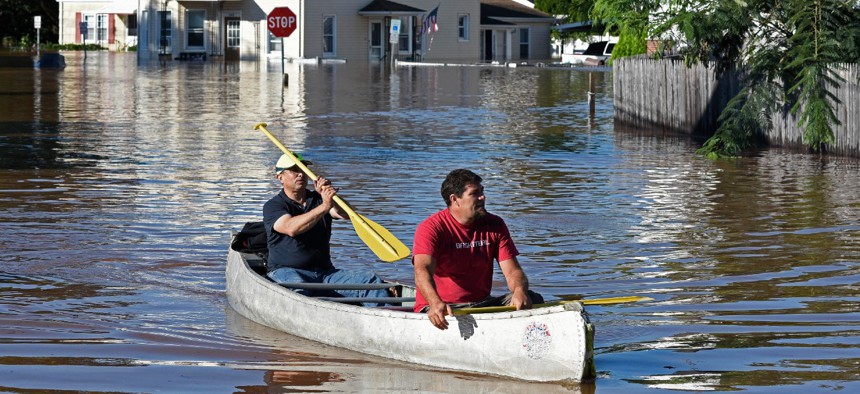
Residents canoe through floodwater in the aftermath of Hurricane Ida in Manville, N.J., on Thursday. Carlos Gonzalez / AP
OPM Issues Guidance on Weather Leave in Age of Telework, Disasters
As the remnants of Hurricane Ida created disruptions throughout the eastern United States, the Office of Personnel Management highlighted how workplace flexibilities can mesh with the federal government’s current maximum telework posture.
The Office of Personnel Management on Wednesday issued guidance reminding federal agencies of the workplace flexibilities available for employees impacted by severe weather events like Hurricane Ida, even during a period when much of the federal workforce is already working remotely.
Hurricane Ida made landfall along the Gulf Coast on Sunday, knocking out the power to the city of New Orleans. As its remnants moved inland, the storm caused a tornado in Annapolis, Md., and widespread flooding in New York and New Jersey.
Although weather and safety leave has long been a tool agencies can use to provide time off to federal workers impacted by storms and other natural disasters, it traditionally only applies to teleworking employees in specific circumstances. Given that so many federal employees are teleworking full time due to the COVID-19 pandemic, OPM Director Kiran Ahuja highlighted the parameters for when weather leave can be offered to teleworkers.
“Even if the individual is not prevented from safely traveling to and working at their approved telework site during severe weather and other emergency situations, OPM regulations allow for certain other exceptions that may warrant approval of weather and safety leave,” Ahuja wrote. “Agencies may provide weather and safety leave to a telework program participant if, in the agency’s judgment, the employee could not have reasonably anticipated the severe weather or emergency and thus is not prepared to telework. Additionally, agencies may provide weather and safety leave to a telework program participant if the employee is prepared to work at the telework site but is prevented from safely working there due to the severe weather or emergency situation.”
Some examples of when weather and safety leave may be appropriate for teleworkers are if the employees needed to evacuate from their home ahead of the weather event, or if they were at home and ready to telework but lost power or phone and internet access due to the storm.
Ahuja also noted that agencies have the discretion to authorize advance payments, continuation of pay, as well as payments for travel and expenses to employees who are ordered to evacuate to protect them from being harmed due to an emergency situation. And she outlined the process by which OPM determines whether to establish an Emergency Leave Transfer Program, which establishes a bank of leave that federal employees can donate to colleagues who need time off to recover from a natural disaster or emergency.
“For any presidentially declared disaster or emergency, headquarters offices of agencies with severely adversely affected employees should send an email to pay-leave-policy@opm.gov with the number of employees severely affected and request the establishment of an [emergency leave transfer program],” Ahuja wrote.
The National Treasury Employees Union on Wednesday called on President Biden to direct OPM to move quickly to do just that.
“Generous federal employees around the country would like to assist their colleagues along the Gulf Coast by donating excess paid leave so they can afford to take time off to care for their families and their property,” said NTEU National President Tony Reardon. “The Emergency Leave Transfer Program showcases the compassion that federal employees have for their coworkers in need, and we urge the Office of Personnel Management to quickly activate this program for Hurricane Ida.”







